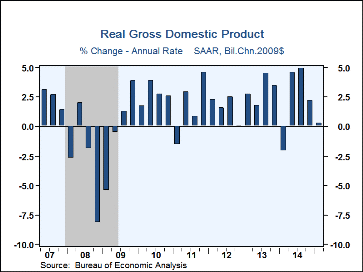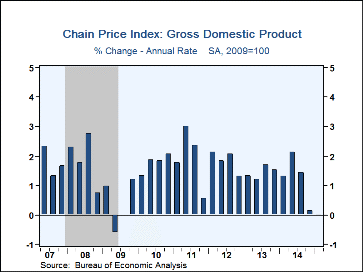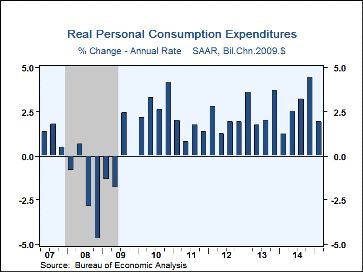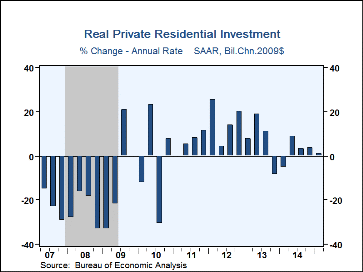 Global| Apr 29 2015
Global| Apr 29 2015U.S. GDP Growth is Negligible as Business Investment and Exports Decline
by:Tom Moeller
|in:Economy in Brief
Summary
Real GDP growth of 0.2% (3.0% y/y) last quarter followed an unrevised 2.2% Q4 gain. The increase disappointed expectations for a 1.1% rise in the Action Economics Forecast Survey. Last quarter's economic performance was its weakest in [...]
Real GDP growth of 0.2% (3.0% y/y) last quarter followed an unrevised 2.2% Q4 gain. The increase disappointed expectations for a 1.1% rise in the Action Economics Forecast Survey. Last quarter's economic performance was its weakest in a year, held back by a 3.4% decline in business investment and deterioration in the foreign trade deficit.
The decline in investment was led by a 23.0% shortfall (-1.0% y/y) in spending on structures. It reflected a 48.6% drop (-6.6% y/y) in mining, shafts & wells. Equipment investment was little-changed (+5.6% y/y) as information processing (+6.7% y/y) as well as industrial equipment (+6.0% y/y) declined at roughly 8.0% annual rates. Transportation equipment jumped 23.7% (13.1% y/y).
Deterioration in net exports sapped 1.3 percentage points from GDP growth last quarter and has subtracted 0.4 percentage points during the last year. Exports fell at a 7.2% rate (+3.0% y/y) due to recessions abroad. The decline was the first in a year. Notable shortfalls were realized in most categories. Services exports, however, gained 7.3% (4.6% y/y) due to foreigners' visits to the U.S. Imports increased 1.8% (5.5% y/y) as goods rose 0.9% (5.4% y/y) and services jumped 6.3% (5.7% y/y).
Government investment fell 0.8% (+0.8% y/y). State & local spending fell 1.5% (+1.1% y/y) but federal spending gained 0.3% (0.3% y/y).
Personal consumption expenditures offset some of these pressures with a 1.9% rise, though that was the weakest gain in a year. Lower prices prompted a 5.6% jump (3.0% y/y) in fuel consumption. That was accompanied by a 4.0% rise (10.5% y/y) in recreational goods & vehicles and a 3.3% gain (7.2% y/y) in furniture & household equipment. Motor vehicles spending eased 2.9% (+7.5% y/y), its first decline in nearly two years. Services spending grew at a 2.8% rate (2.6% y/y), held back by a 0.1% slip (+0.6% y/y) in recreation. Health care spending ramped up 5.5% both quarterly and y/y.
Residential investment grew at a modest 1.3% rate (4.2% y/y), the weakest rise since a decline one year ago.
Inventory investment added 0.7 percentage points to economic growth last quarter. The addition followed subtractions during four of the prior five quarters.
Economic weakness helped the chain price index slip at a 0.1% annual rate (+0.9% y/y). Consumer prices declined 2.0% (+0.3% y/y), as gasoline prices declined at a 63.2% annual rate (-30.4% y/y). The price index excluding food & energy rose 0.9% (+1.3% y/y). Business fixed investment prices rose 0.6% (0.8% y/y) while residential investment prices gained 2.2% (3.6% y/y), the weakest rise in three quarters.
The latest GDP figures can be found in Haver's USECON and USNA databases; USNA contains basically all of the Bureau of Economic Analysis' detail in the national accounts, including the integrated economic accounts and the recently added GDP data for U.S. Territories. The Action Economics consensus estimates can be found in AS1REPNA.
| Chained 2009 $, %, AR | Q1'15 (Advance Estimate) | Q4'14 | Q3'14 | Q1 Y/Y | 2014 | 2013 | 2012 |
|---|---|---|---|---|---|---|---|
| Gross Domestic Product | 0.2 | 2.2 | 5.0 | 3.0 | 2.4 | 2.2 | 2.3 |
| Inventory Effect | 0.7 | -0.1 | -0.0 | 0.5 | 0.1 | 0.0 | 0.1 |
| Final Sales | -0.5 | 2.3 | 5.0 | 2.5 | 2.3 | 2.2 | 2.2 |
| Foreign Trade Effect | -1.3 | -1.0 | 0.8 | -0.4 | -0.1 | 0.3 | 0.1 |
| Domestic Final Sales | 0.7 | 3.3 | 4.1 | 2.9 | 2.4 | 1.9 | 2.1 |
| Demand Components | |||||||
| Personal Consumption Expenditures | 1.9 | 4.4 | 3.2 | 3.0 | 2.5 | 2.4 | 1.8 |
| Business Fixed Investment | -3.4 | 4.7 | 8.9 | 4.9 | 6.3 | 3.0 | 7.2 |
| Residential Investment | 1.3 | 3.8 | 3.3 | 4.2 | 1.6 | 11.9 | 13.5 |
| Government Spending | -0.8 | -1.9 | 4.4 | 0.8 | -0.2 | -2.0 | -1.4 |
| Chain-Type Price Index | |||||||
| GDP | -0.1 | 0.1 | 1.4 | 0.9 | 1.5 | 1.5 | 1.8 |
| Personal Consumption Expenditures | -2.0 | -0.4 | 1.2 | 0.3 | 1.3 | 1.2 | 1.8 |
| Less Food/Energy | 0.9 | 1.1 | 1.4 | 1.3 | 1.4 | 1.3 | 1.8 |
Tom Moeller
AuthorMore in Author Profile »Prior to joining Haver Analytics in 2000, Mr. Moeller worked as the Economist at Chancellor Capital Management from 1985 to 1999. There, he developed comprehensive economic forecasts and interpreted economic data for equity and fixed income portfolio managers. Also at Chancellor, Mr. Moeller worked as an equity analyst and was responsible for researching and rating companies in the economically sensitive automobile and housing industries for investment in Chancellor’s equity portfolio. Prior to joining Chancellor, Mr. Moeller was an Economist at Citibank from 1979 to 1984. He also analyzed pricing behavior in the metals industry for the Council on Wage and Price Stability in Washington, D.C. In 1999, Mr. Moeller received the award for most accurate forecast from the Forecasters' Club of New York. From 1990 to 1992 he was President of the New York Association for Business Economists. Mr. Moeller earned an M.B.A. in Finance from Fordham University, where he graduated in 1987. He holds a Bachelor of Arts in Economics from George Washington University.












